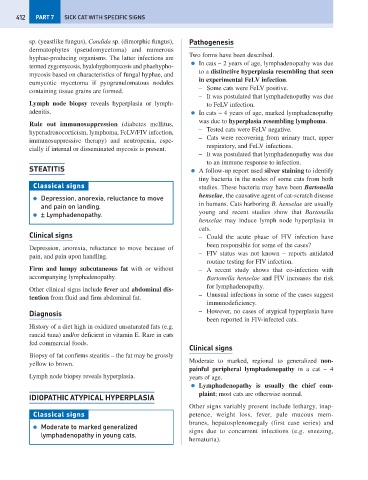Page 420 - Problem-Based Feline Medicine
P. 420
412 PART 7 SICK CAT WITH SPECIFIC SIGNS
sp. (yeastlike fungus), Candida sp. (dimorphic fungus), Pathogenesis
dermatophytes (pseudomycetoma) and numerous
Two forms have been described.
hyphae-producing organisms. The latter infections are
● In cats ~ 2 years of age, lymphadenopathy was due
termed zygomycosis, hyalohyphomycosis and phaehypho-
to a distinctive hyperplasia resembling that seen
mycosis based on characteristics of fungal hyphae, and
in experimental FeLV infection.
eumycotic mycetoma if pyogranulomatous nodules
– Some cats were FeLV positive.
containing tissue grains are formed.
– It was postulated that lymphadenopathy was due
Lymph node biopsy reveals hyperplasia or lymph- to FeLV infection.
adenitis. ● In cats ~ 4 years of age, marked lymphadenopathy
was due to hyperplasia resembling lymphoma.
Rule out immunosuppression (diabetes mellitus,
– Tested cats were FeLV negative.
hyperadrenocorticism, lymphoma, FeLV/FIV infection,
– Cats were recovering from urinary tract, upper
immunosuppressive therapy) and neutropenia, espe-
respiratory, and FeLV infections.
cially if internal or disseminated mycosis is present.
– It was postulated that lymphadenopathy was due
to an immune response to infection.
STEATITIS ● A follow-up report used silver staining to identify
tiny bacteria in the nodes of some cats from both
Classical signs studies. These bacteria may have been Bartonella
henselae, the causative agent of cat-scratch disease
● Depression, anorexia, reluctance to move
in humans. Cats harboring B. henselae are usually
and pain on landing.
young and recent studies show that Bartonella
● ± Lymphadenopathy.
henselae may induce lymph node hyperplasia in
cats.
Clinical signs – Could the acute phase of FIV infection have
been responsible for some of the cases?
Depression, anorexia, reluctance to move because of
– FIV status was not known – reports antidated
pain, and pain upon handling.
routine testing for FIV infection.
Firm and lumpy subcutaneous fat with or without – A recent study shows that co-infection with
accompanying lymphadenopathy. Bartonella henselae and FIV increases the risk
for lymphadenopathy.
Other clinical signs include fever and abdominal dis-
– Unusual infections in some of the cases suggest
tention from fluid and firm abdominal fat.
immunodeficiency.
Diagnosis – However, no cases of atypical hyperplasia have
been reported in FIV-infected cats.
History of a diet high in oxidized unsaturated fats (e.g.
rancid tuna) and/or deficient in vitamin E. Rare in cats
fed commercial foods.
Clinical signs
Biopsy of fat confirms steatitis – the fat may be grossly
Moderate to marked, regional to generalized non-
yellow to brown.
painful peripheral lymphadenopathy in a cat ~ 4
Lymph node biopsy reveals hyperplasia. years of age.
● Lymphadenopathy is usually the chief com-
plaint; most cats are otherwise normal.
IDIOPATHIC ATYPICAL HYPERPLASIA
Other signs variably present include lethargy, inap-
Classical signs petence, weight loss, fever, pale mucous mem-
branes, hepatosplenomegaly (first case series) and
● Moderate to marked generalized
signs due to concurrent infections (e.g. sneezing,
lymphadenopathy in young cats.
hematuria).

